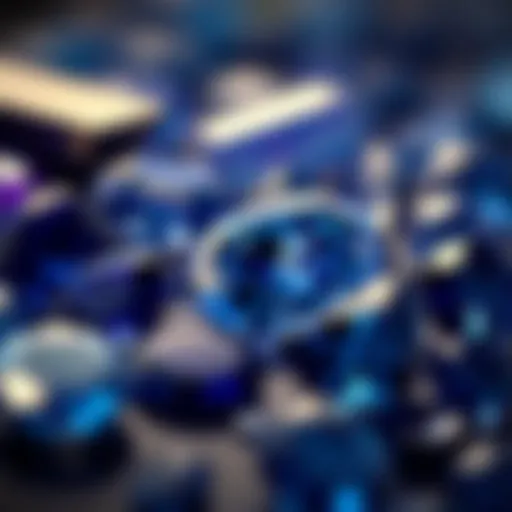Mineral Jewelry: Origins, Craftsmanship, and Trends
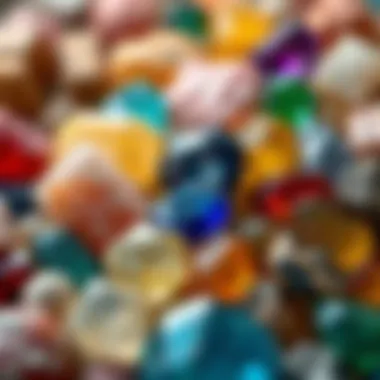
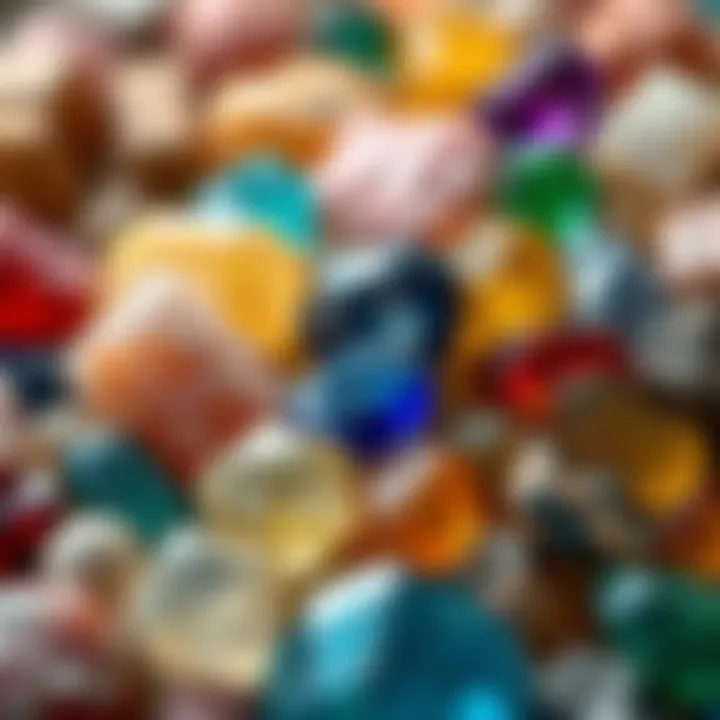
Intro
The realm of mineral jewelry is a captivating intersection where nature’s artistry meets human creativity. As we embark on this journey into the world of mineral adornments, we will unearth the stories hidden within these pieces, stories crafted from the very earth itself. Each gem, rock, or fossil carries a narrative, a testament to the ancient processes that formed it. Whether you're a seasoned collector or just starting your exploration, there's a wealth of knowledge waiting to be uncovered.
In this article, we will delve deep into the history and origins of mineral jewelry, shedding light on the collectible nature of rocks and fossils, and their significant cultural impact throughout history. Additionally, we’ll navigate the essential tools to identify and classify these captivating specimens, ensuring that you leave with not just an appreciation for their beauty, but also an understanding of their stories. We will discuss various mineral types, their unique characteristics, and the craftsmanship that goes into transforming raw materials into wearable art.
Stay with us as we celebrate the intricate allure of mineral jewelry, revealing the trends that shape today’s market, along with care and maintenance tips to preserve your treasured pieces.
Prelude to Mineral Jewelry
The world of mineral jewelry is not merely about adornment; it’s a captivating intersection of natural beauty, artistry, and history. For those who treasure the stories behind their jewelry, understanding mineral jewelry provides a deeper appreciation for each piece. This section lays the groundwork for that understanding, touching on the significance of minerals in jewelry-making and the multitude of factors to consider when diving into this emotive and complex realm.
In the realm of fashion and personal expression, mineral jewelry stands out for its unique qualities and historical narratives. Whether it's a striking sapphire pendant or an ancient amber bead, every mineral holds a tale that connects its wearer to a broader narrative—be it cultural, personal, or geological. Thus, being informed about these elements can allow collectors and enthusiasts to make knowledgeable choices, enhancing their connection to the jewelry they choose to wear or keep.
Definition and Overview
Mineral jewelry refers to ornamental pieces crafted using naturally occurring minerals, including gems, semi-precious stones, and organic materials. Each piece is typically distinguished by its unique color, form, and composition, which contribute to its value and desirability. This type of jewelry extends beyond superficial aesthetics; every creation embodies geological processes that might have unfolded over millions of years.
Key types of minerals found in jewelry include gemstones, which are often prized for their rarity and brilliance. Think of sparkling diamonds or lush emeralds, which trigger images of wealth and luxury. In contrast, semi-precious stones like amethyst and citrine captivate with their vibrant colors and organic origins. The organic materials like coral and pearls bring a different texture and story, evoking sea-life narratives and treasured natural formations.
Historical Background
The significance of mineral jewelry is deeply rooted in human history. Ancient cultures recognized the beauty and power of these stones, and they weren't just for adornment—they were imbued with symbolism and meaning. For instance, the Egyptians adorned themselves with turquoise and lapis lazuli, believing these stones offered protection and adorned the tombs of pharaohs as a gateway to the afterlife. This historical reverence continued through the ages, evolving alongside societies and their changing values.
In the Middle Ages, for instance, gemstones like garnets were crafted into intricate pieces, often representing status or affiliation with certain guilds or families. Moving forward to the Renaissance, we see an explosion of creativity as artists began to explore the aesthetic potential of minerals, incorporating them into more elaborate designs, reflecting the era’s trend towards opulence.
The modern era has seen mineral jewelry flourish, driven by both technology and a renewed appreciation for natural materials. The rise of ethical sourcing now encourages consumers to seek out pieces that are not only beautiful but also responsibly obtained, ensuring that the stories behind these minerals continue to reflect values of sustainability and authenticity.
As we explore this intricate world further in this article, we’ll delve into the various types of minerals used in jewelry-making, their characteristics, the craftsmanship involved, and the cultural significance that endures through time. This wider understanding could very well enhance how one perceives their jewelry—transforming each piece from mere decoration to a tangible connection to history and nature.
Types of Minerals in Jewelry
The realm of mineral jewelry is one that combines art, color, and the very essence of nature through the use of precious and semi-precious materials. The types of minerals utilized in jewelry not only define the aesthetic appeal of each piece but also impact its characteristics and significance. Understanding these elements is essential for anyone looking to appreciate the complexity of jewelry design. The choice of minerals involves considerations like rarity, hardness, and cultural meanings, which altogether shape the value and allure of jewelry.
Gemstones
Diamonds
Diamonds stand as the pinnacle of gemstones. They are widely recognized for their exceptional hardness, which makes them more than just beautiful; they're practically indestructible. This characteristic contributes to diamonds being a traditional choice for engagement rings, symbolizing enduring love. A unique feature of diamonds is their ability to reflect light; their brilliance can captivate onlookers. However, the ethical concerns surrounding diamond mining can be a double-edged sword, leading some consumers to seek alternatives like laboratory-grown diamonds, which boast clarity without the ethical baggage.
Sapphires
Sapphires come in a beautiful array of colors, but the rich blue variety often steals the show. This gemstone is favored in both fashion and formal jewelry, thanks largely to its resilience and stunning hue. The particular optical phenomenon known as asterism, where a star-like pattern appears under light, gives sapphires an enchanting quality that sets them apart. While sapphires are generally durable, their cost can vary significantly based on color intensity and clarity, which can be a consideration for buyers evaluating their options.
Emeralds
Emeralds are rich green gemstones, famed for their vibrant hue and inherent inclusions, which are often likened to nature's fingerprints. Their captivating color makes them a popular choice for statement pieces. Emeralds come with a unique significance, often associated with rebirth and love, which enhances their desirability. Nevertheless, their relatively softer nature compared to diamonds and sapphires imposes caution in terms of usage and care, as they can be more prone to scratching and chipping.
Semi-Precious Stones
Amethyst
Amethyst, with its regal purple tones, stands out among semi-precious stones. Associated with tranquility and clarity, it's often chosen for its perceived calming effects. The beauty of amethyst lies not only in its color but also in its accessibility, being more affordable than many precious gems. Its unique feature of quartz crystallization makes each piece diverse, showcasing variations in hue and pattern. On the downside, amethysts are not as hard as some gemstones, making proper care essential to maintain their vibrant appearance.
Citrine
Citrine, with its sunny yellow and orange tones, is often regarded as a joyful stone, believed to bring positivity and good fortune. Its affordability and vibrant color make it a popular alternative for those seeking color in their jewelry without breaking the bank. The unique feature of citrine includes its ability to encourage creative energy, appealing to artists and creators alike. However, citrine’s color can fade if exposed to prolonged sunlight, which may temper its long-term appeal to collectors who seek lasting vibrancy.
Turquoise
Turquoise is indeed a gemstone that encapsulates history and cultural significance, often merging with ancient traditions. Its sky-blue and greenish hues make it distinct, often found in Native American jewelry. Turquoise not only stands out for its unique color but also for being one of the few gemstones that have spiritual associations in various cultures, related to protection and healing. However, its porous nature means it can be susceptible to damage from cosmetics or harsh chemicals, which presents a consideration for maintenance.
Organic Materials
Amber
Amber, while not a mineral in the traditional sense, is highly valued in jewelry for its organic beauty. Often containing ancient inclusions like insects, each piece tells a story frozen in time. Its warm golden hues bring a soft, natural touch to jewelry designs. Amber often symbolizes warmth and healing, making it appealing to many buyers. The softness of amber also means it requires gentle handling, which can create concerns for durability over long-term wear.
Coral
Coral jewelry speaks to a unique aesthetic rooted in the ocean's depths. With its vibrant reds, pinks, and whites, coral presents a festive look that is hard to dismiss. Its unique feature is the organic alteration it undergoes as it's processed into jewelry. As a statement of natural beauty, coral also carries ecological implications; sustainable sourcing is a point of concern, as overharvesting threatens coral reefs, creating a dilemma for environmentally-conscious consumers.
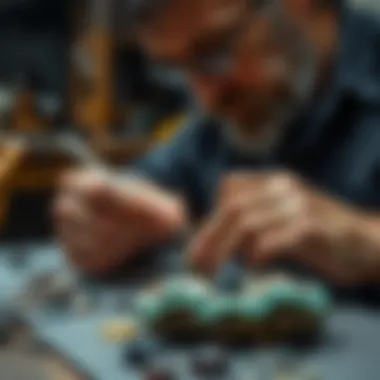
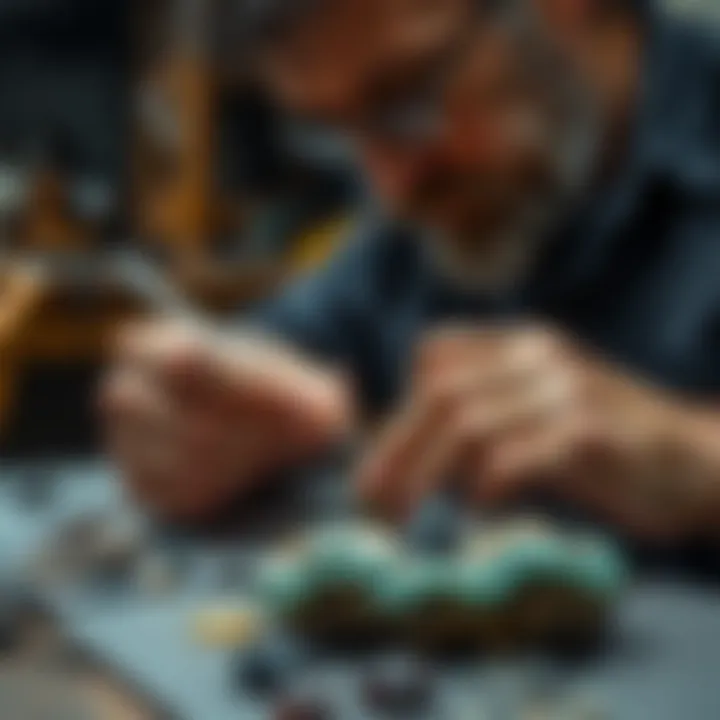
Pearl
Pearls hold a timeless charm and elegance, harvested from mollusks and valued for their luster and rarity. They symbolize purity and sophistication, making them a classic choice for formal occasions. Pearls have the unique characteristic of differing in size, color, and shape, providing collectors with a multitude of choices. However, they can be sensitive to acids and harsh environments, meaning they need diligent care to maintain their pristine condition.
In totality, the types of minerals in jewelry offer a distinct perspective into both craftsmanship and cultural significance. Each material introduces its own lore, which enriches the narrative surrounding not only the pieces themselves but also the collectors and wearers who find personal meaning in them.
The Art of Jewelry Making
The craft of jewelry making is not merely a trade; it’s an art form that combines raw minerals with human creativity. This section digs into the various components and techniques that lay the groundwork for beautiful and intricate mineral jewelry pieces. Understanding the art of jewelry making helps in appreciating the craftsmanship behind every unique piece. It highlights not only the beauty but also the skill and dedication that jewelers pour into their work.
Techniques and Tools
Crafting jewelry requires an array of techniques and tools, each serving specific purposes in the design and construction process.
Metalworking
Metalworking is a cornerstone technique in jewelry creation, involving shaping and manipulating metal to form various structures. This process is fundamental because it allows for the creation of settings that hold gemstones securely. A jeweler’s choice of metal—be it gold, silver, or platinum—can impact not just the look of the piece, but also its durability.
A unique feature of metalworking is the ability to combine different metals into one design, adding depth and texture. However, it’s worth noting that certain metals can tarnish over time, requiring more maintenance than others. Therefore, while metalworking can lead to stunning results, it also demands a understanding of material properties to ensure longevity and appeal.
Stone Setting
Stone setting is all about how a gem or mineral is secured in the metal framework. Different methods, such as prong setting or bezel setting, offer various aesthetic and security benefits. The key characteristic of stone setting lies in its ability to enhance the beauty of the stones while ensuring they remain intact in daily wear.
For instance, prong setting highlights the brilliance of a diamond, allowing light to pass through and reflect beautifully. In contrast, bezel setting wraps the stone securely, offering a modern look while also boosting protection against chips. Yet, this technique demands precision and experience to execute properly, as an improperly set stone can easily become dislodged.
Polishing
Polishing is the finishing touch in the jewelry-making process. It transforms the rough edges of a piece into a smooth, reflective surface that captivates the eye. The process not only improves aesthetics but also enhances durability by removing any surface imperfections that might compromise the piece over time.
However, polishing requires a careful balance. Over-polishing can diminish intricate details that are key to a design. Therefore, a skilled jeweler must know when to stop, ensuring that the final product is both beautiful and retains its original artistry. Polishing is indeed an art that contributes significantly to the allure of mineral jewelry, combining care with technique.
Design Principles
Jewelry design is as important as the making of the piece itself. It involves thoughtful consideration of aesthetics and structure, driving the finished product's appeal.
Aesthetic Considerations
Aesthetic considerations are pivotal in any design project, especially in jewelry. This involves choosing shapes, sizes, and textures that will draw the eye. The choice of mineral, its cut, and the overall design must resonate with the intended audience.
A compelling aesthetic can evoke emotions and tell stories. For instance, a swirling, organic design could be inspired by nature, while minimalistic lines may convey modern sophistication. However, finding the right balance can be tricky, as very ornate designs may not suit every individual’s taste. Thus, these considerations guide the creation process to meet varied preferences.
Balance and Proportion
The principles of balance and proportion are crucial in achieving harmony within a piece of jewelry. Balance refers to the distribution of visual weight, ensuring that no one part overwhelms the others. On the other hand, proportion relates to the size relationship between elements in a design.
These principles promote wearability. A well-balanced piece that fits comfortably will be favored over something that feels off-kilter. It takes a deep understanding of these concepts to create pieces that not only look good but also feel good to wear. Ignoring balance could result in an aesthetically displeasing outcome that quickly loses its appeal over time.
Color Theory
Color theory plays a significant role in jewelry design as it influences how pieces will be perceived. The right color combinations can evoke various emotions and draw attention. Jewelers often employ complementary colors or harmonious palettes to bring a design to life.
A unique aspect of color theory in jewelry is the consideration of how different metals and minerals interact. For example, a rich amethyst contrasted against a warm gold setting can create a striking visual appeal. Still, color choices must be balanced with the target audience’s preferences and current trends, leading to carefully thought-out color schemes that can either complement or detract from the overall design.
"In the world of jewelry, every element matters; the tools, the techniques, and especially the design principles dictate the final piece’s story."
Overall, the art of jewelry making involves a symbiosis of skill, technique, and creativity. By mastering these elements, jewelers craft not just adornments but stories captured in metal and stone.
Cultural Significance of Mineral Jewelry
Mineral jewelry is much more than a mere adornment; it embodies stories, cultural heritage, and personal significance. Historically, these pieces were designed to represent beliefs, milestones, and community ties. Many cultures ascribe power and meaning to the minerals they use, viewing them through the lens of spirituality and tradition. As we navigate through this topic, we will unravel how mineral jewelry has transcended mere aesthetics to play pivotal roles in various societies across the globe.
Symbolism and Meaning
Every gemstone, every mineral carries an echo of myth and meaning. For instance, the deep blue hue of lapis lazuli often symbolizes wisdom and truth, a choice favored in ancient Egypt. Similarly, the vibrant red of garnet not only stands for love but also has roots in protection and security. In this delicate web of symbolism, individuals gravitate toward certain pieces that resonate with their personal journeys. The importance of symbolism in mineral jewelry cannot be overstated; it allows wearers to express their identities and beliefs in visible and tangible ways.
"Jewelry is like a love letter, a tangible sigh that reflects one’s essence and experiences."
Cultural Traditions
Weddings
Weddings frequently feature mineral jewelry as vital components of the celebration. For many, engagement rings made from diamonds are the ultimate declaration of love. It's not merely about the sparkle; it's about the promise and commitment symbolized in that stone. In various cultures, specific minerals are believed to bring good fortune to the union. For example, in Indian tradition, the mangalsutra—often adorned with black beads and gold—represents the bride's marital status, a powerful signifier of her role within the family and society. This blend of personal sentiment and cultural significance makes mineral jewelry an essential element of wedding customs.

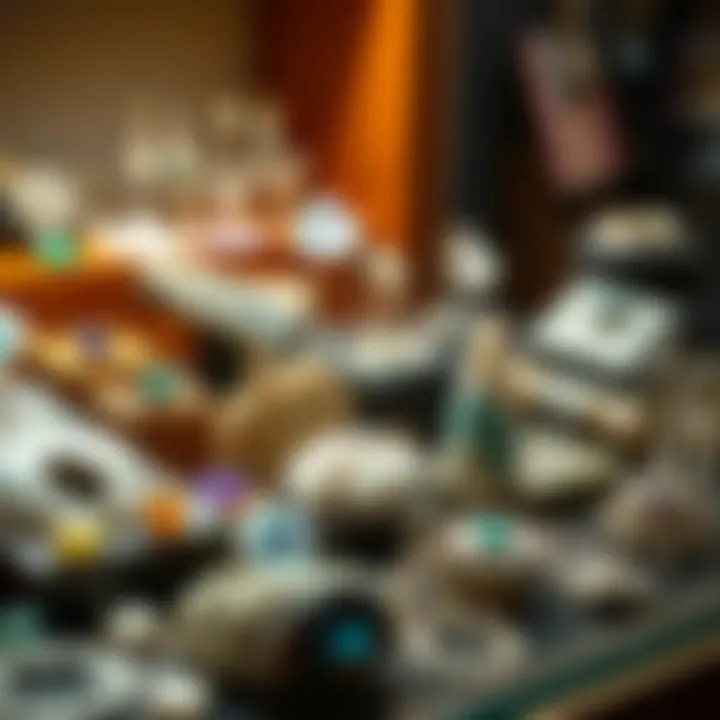
Rituals
Rituals underscore the importance of mineral jewelry in defining cultural identity. Various rites of passage, be it a coming-of-age ceremony or a rite of passage in spiritual beliefs, often incorporate mineral adornments. In Native American communities, turquoise holds a sacred position, associated with protection and healing. Wearing such pieces during rituals draws on the collective history and beliefs of the community, grounding individuals in their heritage. Amongst many, this usage imbues the jewelry with a sense of depth and continuity, linking generations through shared practices.
Status Symbols
Throughout history, jewelry made from rare minerals has often been perceived as status symbols. Wealth and power are indicated through the ownership and display of high-quality gemstones and unique designs. In contemporary society, this is still evident with certain brands like Cartier or Tiffany & Co. whose collections not only boast exquisite craftsmanship but also symbolize exclusivity and prestige. Mineral jewelry as a status symbol can be a double-edged sword. While it brings visibility to the wearer’s achievements, it can also foster a culture of comparison and materialism, which some may find disconcerting.
By examining the cultural significance surrounding mineral jewelry, we can appreciate its role as a profound medium through which personal stories and collective traditions are told. As we shift towards contemporary applications and meanings of mineral jewelry, it continues to evolve, marrying tradition with modernity in fascinating ways.
Ethical Sourcing and Sustainability
In an era where consumers grow increasingly aware of the choices they make, ethical sourcing and sustainability in mineral jewelry is paramount. This isn't just about looking good; it's about feeling good too, knowing that the pieces we wear are sourced responsibly. The journey of a gemstone from its natural habitat to your jewelry box can have lasting repercussions on the environment and the communities involved in the mining process. By understanding these implications, we can foster a more conscientious approach towards purchasing and wearing mineral jewelry.
Sourcing Practices
The processes involved in sourcing minerals have intensified scrutiny from both consumers and activists alike. It's essential to consider not only where the gemstones come from but also how they are extracted. Ethical sourcing practices emphasize transparency and responsibility. This includes:
- Fair Labor: Ensuring that the workers involved, often in dire conditions, receive fair wages and work in safe environments.
- Conflict-Free Gemstones: Supporting policies that require gemstones to be sourced from regions that do not fund conflict or human rights abuses��—often termed conflict minerals.
- Small-Scale Mining: Supporting artisanal and small-scale mining operations, which can often be more sustainable and provide better benefits to local communities compared to industrial mining operations.
By choosing brands and designers that adhere to these practices, consumers can help create a demand for ethically sourced materials. It’s a simple way to align personal values with purchasing habits.
Environmental Impact
The extraction of minerals, while dazzling in its output, can have detrimental effects on the environment. Understanding this impact is a crucial part of the discussion around sustainability in mineral jewelry. Key issues include:
- Ecosystem Disruption: Mining can lead to habitat destruction and the disruption of local ecosystems. For instance, large-scale mining often requires significant clearing of land.
- Water Pollution: The process of extracting valuable minerals frequently involves harmful chemicals, which, when not managed properly, can contaminate water supplies affecting local communities.
- Carbon Footprint: The energy-intensive processes of mining and transporting minerals add considerable carbon emissions to a planet already suffering from climate change.
"An ethical approach to mineral jewelry isn't simply trendy; it's essential. Consumers have the power to influence industries."
Ultimately, being aware of these factors not only enriches the understanding of the jewelry we wear but also fosters a sense of responsibility. In making informed choices, we not only embrace the beauty of these natural minerals but also contribute to a more sustainable and ethical jewelry market.
For more insight on the environmental implications of mining, visit Environmental Impact of Mining on Britannica. Additionally, consider the impact of your jewelry choices discussed in various threads on Reddit.
By advocating for and supporting ethical practices in the mineral jewelry industry, we can all play a part in nurturing not only our aesthetic interests but also the well-being of our planet and its diverse communities.
Market Trends in Mineral Jewelry
Examining the market trends in mineral jewelry is like peering through a kaleidoscope of changing aesthetics, consumer preferences, and technological developments. This section serves as a compass for those navigating the world of mineral jewelry, providing crucial insight into how various facets of the industry are evolving. Trends not only reflect current tastes but also set the stage for future innovations. Understanding these trends helps collectors, designers, and investors alike to make informed decisions, ensuring that both personal and financial investments are on solid footing.
Contemporary Innovations
In recent years, innovation has taken center stage in the realm of mineral jewelry. Technological advancements have revolutionized how pieces are crafted, marketed, and sold. For instance, the use of 3D printing technology allows designers to create intricate patterns and forms that were previously unthinkable. Designers are not just limited to traditional materials anymore; alternatives like lab-grown gemstones are blurring the lines between organic and synthetic, offering an eco-friendly option for the environmentally conscious consumer.
- 3D Printing: This not only reduces waste but also enables the customization of jewelry pieces, allowing consumers to personalize their adornments in ways they never could before.
- Smart Jewelry: Intersection of technology and fashion is evident in the rise of smart jewelry, such as rings and bracelets equipped with health monitoring sensors. These pieces provide functionality while maintaining aesthetic appeal, meeting the needs of modern consumers who prioritize both style and utility.
- Online Marketplaces: Platforms like Etsy and Instagram have transformed how consumers shop for mineral jewelry. It allows artisans from all over the world to showcase their work, offering a platform for unique and often one-of-a-kind pieces. This trend also heralds a move toward valuing craftsmanship over mass production.
"Today, personalization and sustainability are driving the jewelry market, shifting focus from mere adornment to expressing individuality and conscience."
As designs grow more experimental, directions in styling are influenced by cultural shifts, with many consumers focusing on pieces that tell a story or reflect personal journey. This opens up new opportunities for gemstone and mineral appreciation.
Retro Revivals
Throwbacks often hold a charm that current designs struggle to replicate. In the mineral jewelry scene, retro revivals have become a noteworthy trend. This resurgence taps into nostalgia while also appealing to those who appreciate the craftsmanship of yesteryear. Several aspects characterize this trend:
- Vintage Styles: Many collectors now seek vintage and antique pieces, particularly those from the Art Deco and Victorian eras. The intricate detailing and unique cuts from these times provide a stark contrast to the sleek minimalism that dominates today's jewelry design.
- Replicas of Classic Designs: Some contemporary brands have capitalized on nostalgia by releasing modern replicas of iconic designs. They maintain classic elements while infusing modern sensibilities, bridging the gap between the past and present.
- Sustainable Vintage: The increasing focus on sustainability has sparked a rising interest in vintage jewelry as an eco-friendly option. Pre-owned pieces have less environmental impact, allowing consumers to embrace style without guilt.
The trend of looking backward does not diminish the forward momentum of the industry. Rather, it showcases how past styles and contemporary techniques can harmoniously coexist. In this swirling dance between innovation and nostalgia, mineral jewelry continues to evolve, ensuring a vibrant future designed by the hands of skilled artisans.
By keeping a close eye on these market trends, enthusiasts can gain a fuller appreciation of not just the pieces they adore, but also the story behind them.
Care and Maintenance of Mineral Jewelry
Maintaining the beauty and integrity of mineral jewelry is crucial for both collectors and enthusiasts alike. Just like any treasured artifact, these pieces deserve attention and care to ensure they withstand the test of time. Not only does proper upkeep prolong the life of the jewelry, but it also preserves its aesthetic appeal and sentimental value. Mineral jewelry, often embedded with intricate designs and delicate stones, can suffer from environmental factors and daily wear if not cared for appropriately. Thus, understanding cleaning and storage techniques is essential to protect these investments.
Cleaning Techniques
Regular cleaning is the cornerstone of jewelry maintenance. However, it’s important to understand that different materials require varying approaches to avoid damage. Here are a few strategies tailored for the types of commonly used minerals:
- Soft Cloth Wipe: For gemstones like amethyst or citrine, a simple routine of wiping them down with a soft, lint-free cloth after each wear can keep them shining.
- Gentle Soapy Water: For pieces that might be dirty from everyday wear, you can use soapy water. Mix a few drops of mild dish soap with lukewarm water, soak the jewelry briefly, and then lightly scrub with a soft toothbrush.
- Avoid Harsh Chemicals: It’s vital to steer clear of abrasive cleaners or ammonia. These substances can erode the luster and weaken settings. If your jewelry has intricate details or inlaid stones, a professional clean may be warranted from time to time.
- Storage Cleaning: When storing jewelry, it’s a good practice to clean it first. Oils from skin can attract dust, leading to tarnishing if left uncleaned.
"A little vigilance goes a long way to preserving the beauty of mineral jewelry for generations to come."
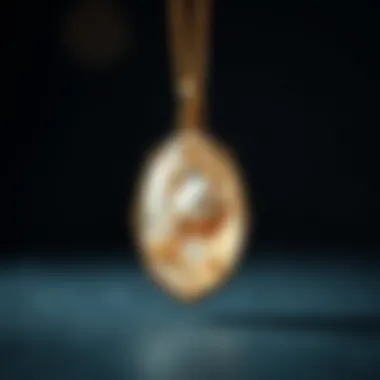
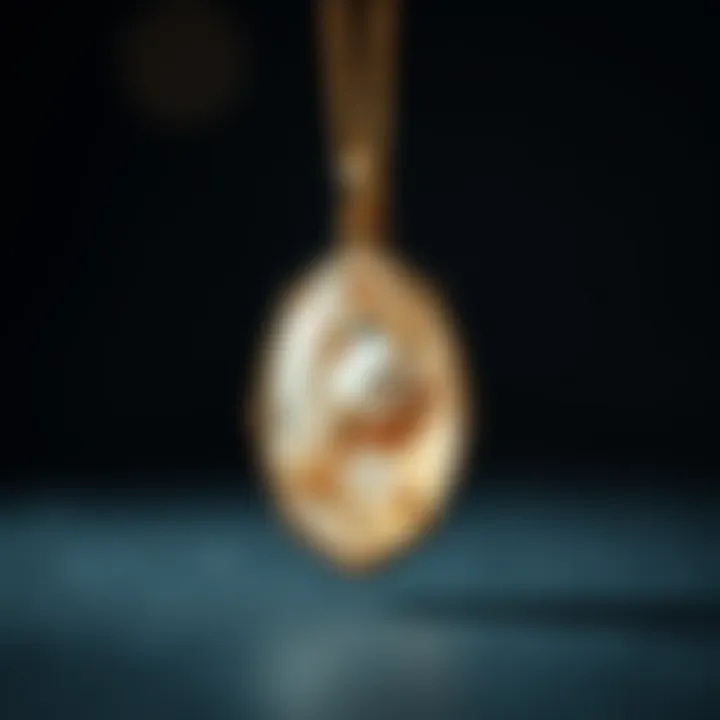
Storage Solutions
Keeping mineral jewelry safe from potential damage requires careful attention to how and where it is stored. Here are some efficient storage solutions:
- Individual Pouches: Use soft pouches or separate compartments within a jewelry box to prevent pieces from scratching each other. This is particularly important for softer stones like opal and moonstone.
- Cool, Dry Environment: Humidity and heat can be detrimental. Ideally, jewelry should be stored in a cool, dry place. Avoid leaving items in bathrooms or near kitchen stoves.
- Silica Gel Packs: Including silica gel packs in your storage can help absorb moisture, further protecting against tarnish.
- Avoid Sunlight: Direct sunlight can fade colored minerals over time; hence storage should be away from windows.
Employing these strategies will go a long way towards keeping your mineral jewelry in prime condition, allowing it to dazzle for years to come. By being mindful of how we clean and store these exquisite pieces, we honor both their beauty and their history.
Notable Designers and Brands in Mineral Jewelry
In the intricate journey of mineral jewelry, the role of notable designers and brands can't be overstated. These individuals and companies not only shape trends but also often elevate the value and understanding of this art form. Their unique perspectives and creativity breathe life into raw minerals, transforming them into wearable art that can be appreciated for both aesthetic and intrinsic value. The craftsmanship showcased by various designers can tell a story behind each piece, making them indispensable to collectors and enthusiasts alike.
Emerging Talents
The landscape of mineral jewelry is continually evolving, driven by fresh ideas and innovative approaches from emerging talents. New designers bring a flair that is often less bound by tradition, allowing for a reimagining of classic forms and materials. For instance, consider the work of a young designer from Portland who focuses on sustainable materials and ethical practices. By using recycled metals and responsibly sourced stones, they're not only crafting beautiful pieces but also making a statement about environmental consciousness.
Emerging designers often experiment with forms and techniques, leading to the birth of pieces that may defy conventional expectations. One such example is a designer utilizing raw, uncut stones that capture the natural beauty and imperfections of minerals. Each piece resonates with authenticity, often reflecting a connection to the earth that appeals to discerning collectors interested in unique additions to their collections.
To follow this trend in emerging talents, platforms like Instagram or Etsy are good starting points. These platforms are a treasure trove for discovering new names and innovative designs. It is an excellent way for collectors—especially those keen on forging connections with the creators—to understand the stories and intentions behind the jewelry that they admire.
Established Brands
In contrast to the fresh faces in the market, established brands like Tiffany & Co. and Cartier have created a legacy that endures. Their long-standing reputations give weight to their creations and inspire trust in consumers. These brands have honed their craft over decades, if not centuries, ensuring not just quality but also a kind of timelessness in style.
Established brands often marry luxury with meticulous craftsmanship. Diamonds and precious stones are sourced from ethical suppliers, undergoing stringent quality checks before reaching the public. This doesn’t merely translate into visual splendor; the marketing, branding, and storytelling associated with these pieces resonate strongly with buyers seeking discernible value.
However, it’s worth noting that the stability of established brands contrasts sharply with the dynamic nature of new designers. Collectors might find themselves drawn to pieces from both sides: the classic integrity offered by established brands and the bold innovations from newer names. Having both in a collection can not only enrich the overall aesthetic but may also provide varying market values, thus serving as a strategic investment approach.
"The art of jewelry is not just found in the sparkle of the stones but in the stories crafted by the artisans who shape them."
Engaging with both established brands and emerging talents offers a more rounded experience for collectors of mineral jewelry. Be it the rich history that established brands bring or the fresh energy that new designers infuse, the realm of mineral jewelry continues to thrive on diversity and innovation.
Mineral Jewelry as Investment
Investing in mineral jewelry can be more than just a delightful hobby; it often serves as a tangible asset that can appreciate over time. The unique allure of these pieces lies not only in their beauty but also in their potential to deliver financial rewards. Recent trends show a significant uptick in buyer interest for both natural and uniquely crafted pieces. This is an enticing prospect for collectors and investors alike.
The intrinsic value of mineral jewelry can often be determined by several valuation factors. First and foremost, the quality of the materials used in the jewelry piece—like the type of mineral, cut, clarity, and color—plays a substantial role. For those keen on investing, understanding these factors is crucial in acquiring pieces that hold high resale value. It’s essential to educate oneself on how lab-created stones differ from natural ones, as their market appeal significantly contrasts.
"Knowing what you are looking for can turn a simple purchase into an appreciating investment."
The piece’s craftsmanship also matters immensely—jewelry made by well-known designers or created through meticulous techniques tends to hold its value better. Furthermore, scarcity contributes to valuation; the rarer the gemstone or the creative design, the more likely it is to maintain or increase in value over time.
Valuation Factors
Several core elements contribute to the valuation of mineral jewelry:
- Material Quality: The main mineral used, whether ruby, diamond, or semi-precious stones, significantly affects the piece's worth.
- Craftsmanship: The expertise involved in designing and creating the jewelry can differentiate a mundane piece from a collector's treasure.
- Provenance: Jewelry with an interesting history or prior ownership can fetch a higher price.
- Market Trends: Watching industry experts and market developments will help identify which minerals are gaining popularity.
In summary, a focused understanding of these valuation factors will bolster anyone's approach to investing in mineral jewelry.
Market Risks and Rewards
Just like any investment vehicle, mineral jewelry is not without its risks. The marketplace can be erratic, influenced by consumer trends and economics. A valuable piece today might not hold the same allure in a few years, especially if newer trends emerge or if the global market stabilizes.
However, there are rewards as well. With astute buying and some luck, investors may find themselves in possession of pieces that not only appreciate in value but also resonate on a personal level. The satisfaction of realizing a return on investment while enjoying the aesthetic allure of the jewelry is a unique experience that many collectors treasure.
To navigate these ups and downs, potential investors should:
- Do Thorough Research: Understand current market conditions and what types of minerals are trending.
- Buy Wisely: Focus on unique pieces with high-quality craftsmanship.
- Build Relationships: Cultivate connections with reputable dealers and fellow collectors for inside knowledge.
The Future of Mineral Jewelry
As we step forward into an era characterized by rapid technological evolution and shifting consumer habits, the future of mineral jewelry holds remarkable potential. This topic is paramount in understanding how mineral jewelry will not only adapt but also thrive in the dynamic marketplace. By examining technological advances and changing consumer preferences, we unravel the intricate tapestry that will define mineral jewelry's landscape in the years to come.
Technological Advances
The realm of jewelry design and production has never been more exciting. With the advent of advanced technologies like 3D printing, artificial intelligence, and augmented reality, the potential for creating unique pieces is limitless. 3D printing, in particular, allows artisans to produce complex, intricate designs that would be labor-intensive, if not impossible, through traditional methods. Imagine a ring that fits perfectly without the need for manual sizing—precision like never before.
Moreover, technology facilitates gemological analysis through tools that can assess a stone's quality faster and more accurately than ever, helping collectors and consumers distinguish genuine articles from synthetics or enhancements. As a result, the trust in purchasing online increases, drawing more enthusiasts into the fold. The marriage of craftsmanship and technology not only preserves traditional techniques but also introduces innovative ways to captivate customers.
"In this rapidly evolving landscape, both technology and artistry must inform and inspire the design process."
Changing Consumer Preferences
A not-so-subtle shift occurs in consumer habits, particularly among millennials and Generation Z. This younger demographic seeks authenticity and sustainability. In the jewelry realm, this translates into a preference for ethically sourced materials, transparent supply chains, and even second-hand pieces. Consumers are more likely to scrutinize the origins of their gems and metals, favoring brands that share their values.
Alongside an inclination towards ethical choices, there’s a desire for personalization. People no longer just want a sparkly ring. They wish for a piece that tells a story—maybe a family heirloom's essence captured in a modern design. Customizable jewelry experiences allow them to engage directly with designers, fostering a sense of connection and ownership that mass production can’t replicate.
To sum up, the future of mineral jewelry lies at the crossroads of technology and evolving consumer values. With an emphasis on sustainability, craftsmanship, and innovation, the industry is poised for growth, but only for those willing to adapt to the intertwined dynamics of today’s marketplace. It’s an exhilarating time for both collectors and makers, as they navigate through the luminous realm of mineral jewelry.



